2004 ISUZU TF SERIES engine
[x] Cancel search: enginePage 2686 of 4264
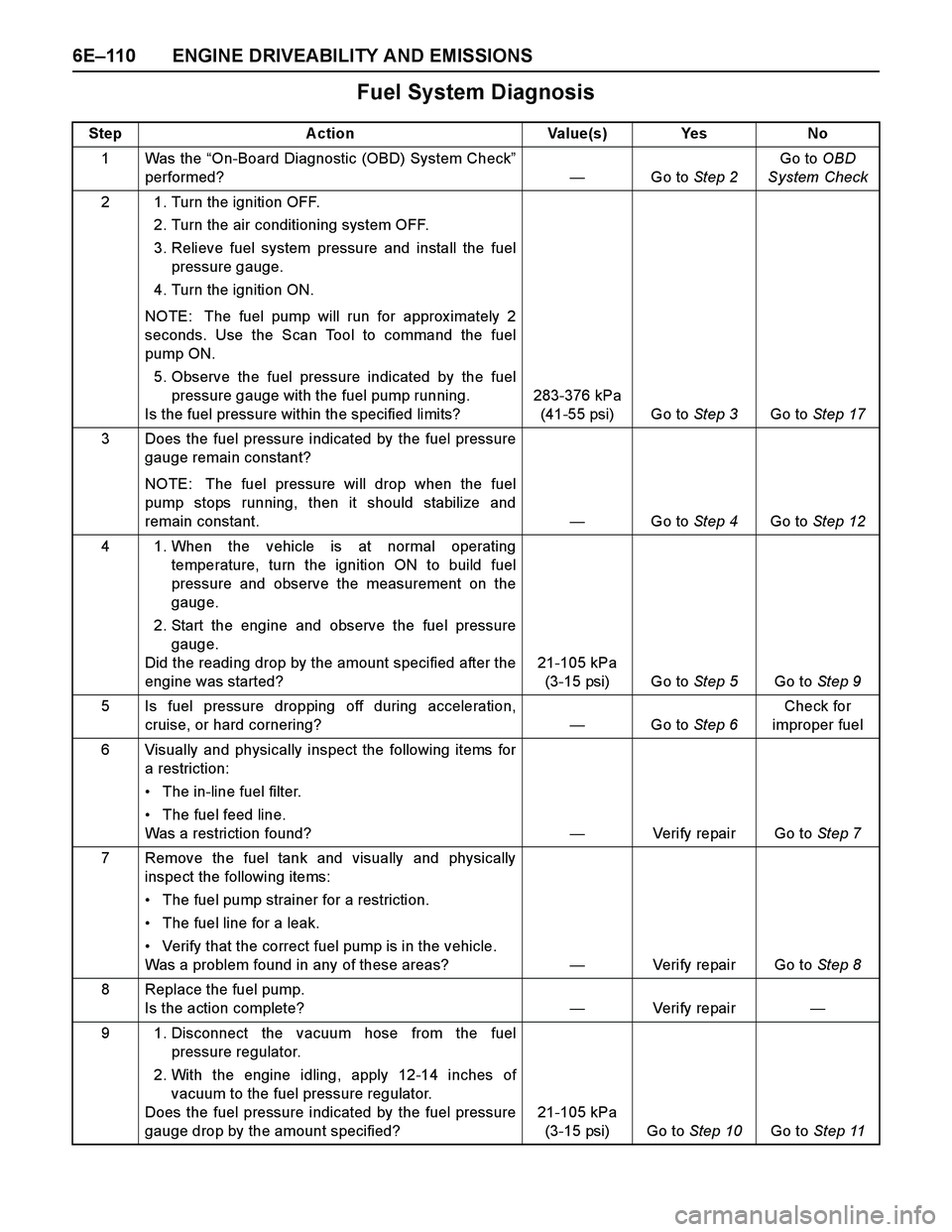
6E–110 ENGINE DRIVEABILITY AND EMISSIONS
Fuel System Diagnosis
Step Action Value(s) Yes No
1Was the “On-Board Diagnostic (OBD) System Check”
performed?—Go to Step 2Go to OBD
System Check
2 1. Turn the ignition OFF.
2. Turn the air conditioning system OFF.
3. Relieve fuel system pressure and install the fuel
pressure gauge.
4. Turn the ignition ON.
NOTE: The fuel pump will run for approx imately 2
seconds. Use the Scan Tool to command the fuel
pump ON.
5. Observe the fuel pressure indicated by the fuel
pressure gauge with the fuel pump running.
Is the fuel pressure within the specified limits?283-376 kPa
(41-55 psi) Go to Step 3Go to Step 17
3 Does the fuel pressure indicated by the fuel pressure
gauge remain constant?
NOTE: The fuel pressure will drop when the fuel
pump stops running, then it should stabilize and
remain constant.—Go to Step 4Go to Step 12
4 1. When the vehicle is at normal operating
temperature, turn the ignition ON to build fuel
pressure and observe the measurement on the
gauge.
2. Start the engine and observe the fuel pressure
gauge.
Did the reading drop by the amount specified after the
engine was started?21-105 kPa
(3-15 psi) Go to Step 5Go to Step 9
5 Is fuel pressure dropping off during acceleration,
cruise, or hard cornering?—Go to Step 6Check for
improper fuel
6 Visually and physically inspect the following items for
a restriction:
The in-line fuel filter.
The fuel feed line.
Was a restriction found?—Verify repair Go to Step 7
7 Remove the fuel tank and visually and physically
inspect the following items:
The fuel pump strainer for a restriction.
The fuel line for a leak.
Verify that the correct fuel pump is in the vehicle.
Was a problem found in any of these areas?—Verify repair Go to Step 8
8 Replace the fuel pump.
Is the action complete?—Veri fy repai r—
9 1. Disconnect the vacuum hose from the fuel
pressure regulator.
2. With the engine idling, apply 12-14 inches of
vacuum to the fuel pressure regulator.
Does the fuel pressure indicated by the fuel pressure
gauge drop by the amount specified?21-105 kPa
(3-15 psi) Go to Step 10Go to Step 11
Page 2687 of 4264
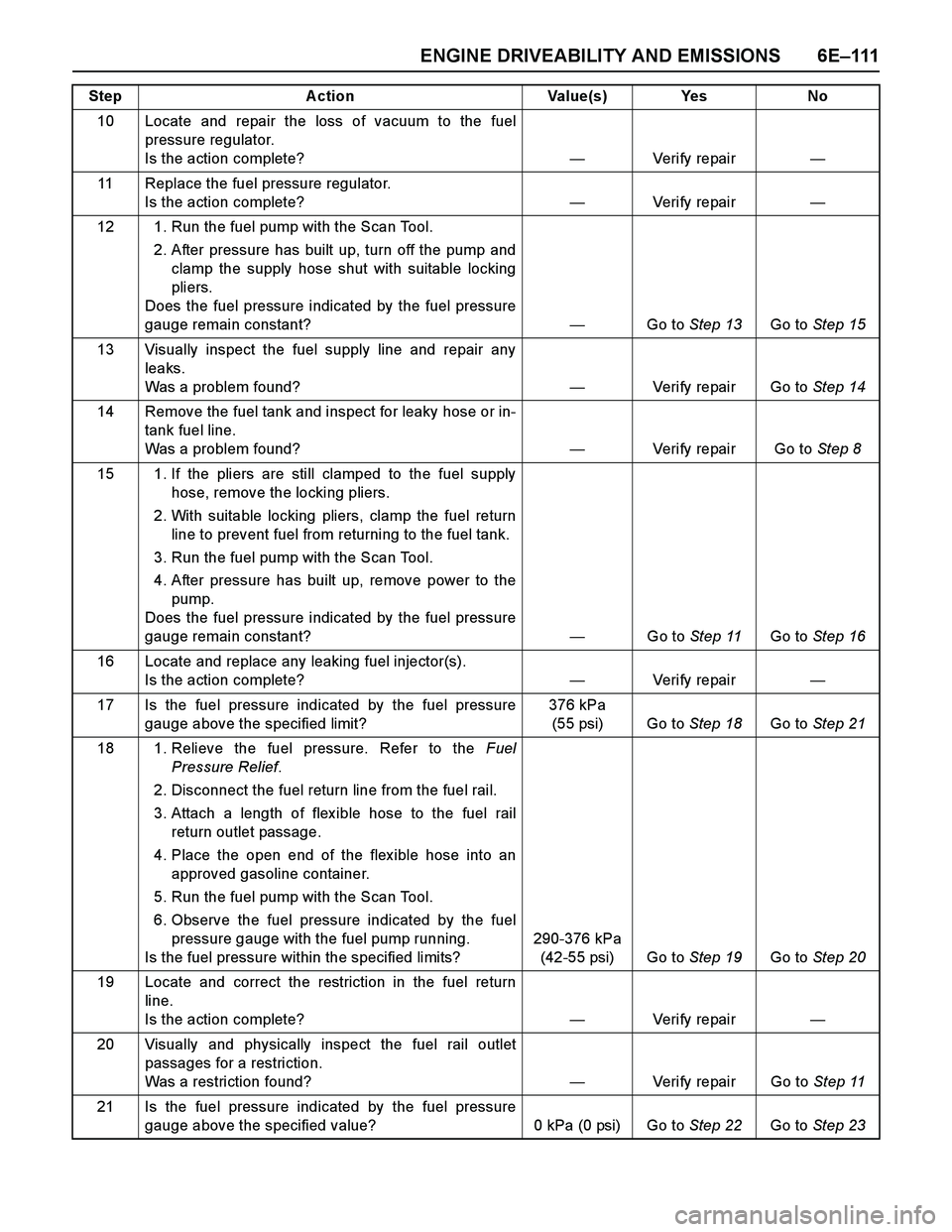
ENGINE DRIVEABILITY AND EMISSIONS 6E–111
10 Locate and repair the loss of vacuum to the fuel
pressure regulator.
Is the action complete?—Veri fy repai r—
11 Replace the fuel pressure regulator.
Is the action complete?—Veri fy repai r—
12 1. Run the fuel pump with the Scan Tool.
2. After pressure has built up, turn off the pump and
clamp the supply hose shut with suitable locking
pliers.
Does the fuel pressure indicated by the fuel pressure
gauge remain constant?—Go to Step 13Go to Step 15
13 Visually inspect the fuel supply line and repair any
leaks.
Was a problem found?—Verify repair Go to Step 14
14 Remove the fuel tank and inspect for leaky hose or in-
tank fuel line.
Was a problem found?—Verify repair Go to Step 8
15 1. If the pliers are still clamped to the fuel supply
hose, remove the locking pliers.
2. With suitable locking pliers, clamp the fuel return
line to prevent fuel from returning to the fuel tank.
3. Run the fuel pump with the Scan Tool.
4. After pressure has built up, remove power to the
pump.
Does the fuel pressure indicated by the fuel pressure
gauge remain constant?—Go to Step 11Go to Step 16
16 Locate and replace any leaking fuel injector(s).
Is the action complete?—Veri fy repai r—
17 Is the fuel pressure indicated by the fuel pressure
gauge above the specified limit?376 kPa
(55 psi) Go to Step 18Go to Step 21
18 1. Relieve the fuel pressure. Refer to the Fuel
Pressure Relief.
2. Disconnect the fuel return line from the fuel rail.
3. Attach a length of flex ible hose to the fuel rail
return outlet passage.
4. Place the open end of the flex ible hose into an
approved gasoline container.
5. Run the fuel pump with the Scan Tool.
6. Observe the fuel pressure indicated by the fuel
pressure gauge with the fuel pump running.
Is the fuel pressure within the specified limits?290-376 kPa
(42-55 psi) Go to Step 19Go to Step 20
19 Locate and correct the restriction in the fuel return
line.
Is the action complete?—Veri fy repai r—
20 Visually and physically inspect the fuel rail outlet
passages for a restriction.
Was a restriction found?—Verify repair Go to Step 11
21 Is the fuel pressure indicated by the fuel pressure
gauge above the specified value? 0 kPa (0 psi) Go to Step 22Go to Step 23 Step Action Value(s) Yes No
Page 2688 of 4264
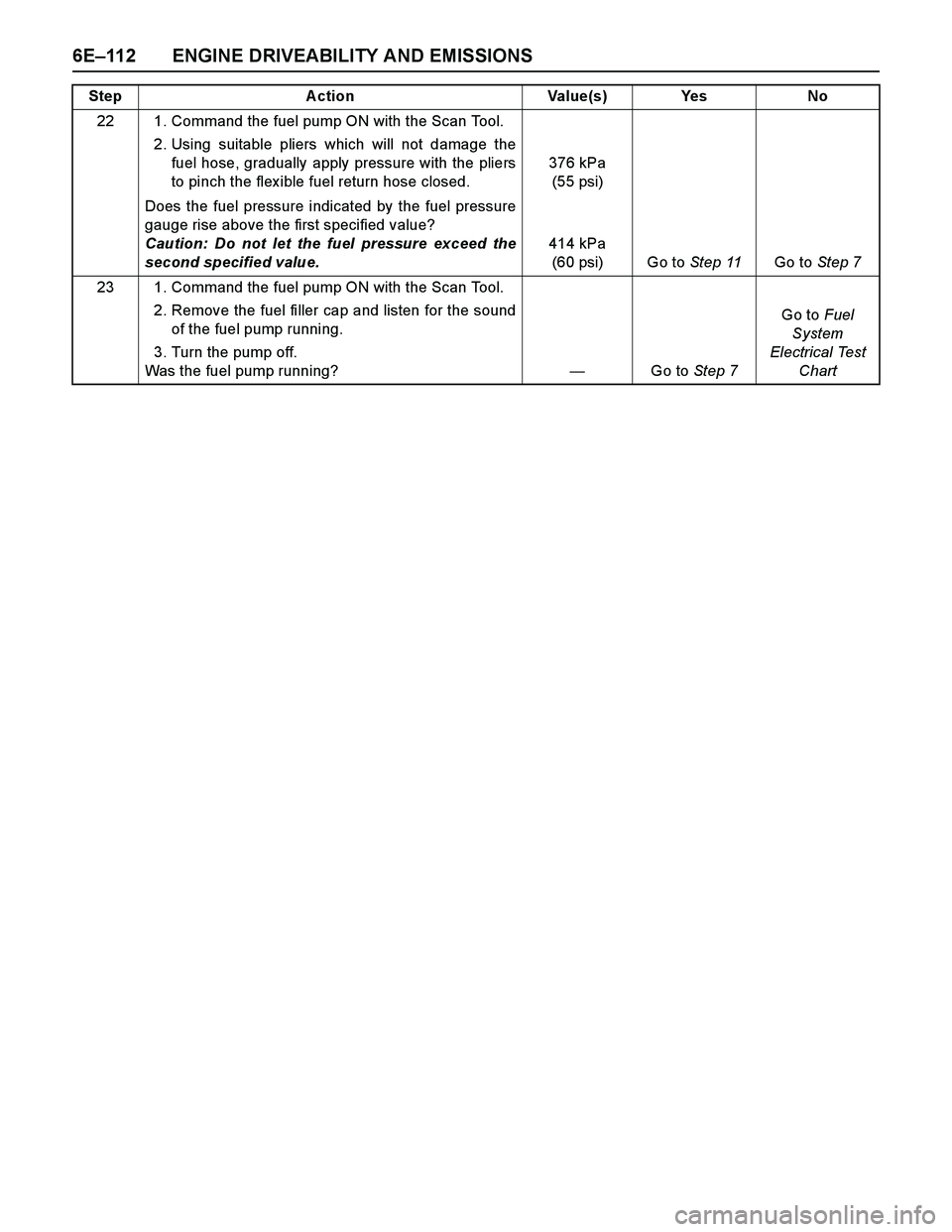
6E–112 ENGINE DRIVEABILITY AND EMISSIONS
22 1. Command the fuel pump ON with the Scan Tool.
2. Using suitable pliers which will not damage the
fuel hose, gradually apply pressure with the pliers
to pinch the flex ible fuel return hose closed.376 kPa
(55 psi)
Does the fuel pressure indicated by the fuel pressure
gauge rise above the first specified value?
Caution: Do not let the fuel pressure exceed the
second specified value.414 kPa
(60 psi) Go to Step 11Go to Step 7
23 1. Command the fuel pump ON with the Scan Tool.
2. Remove the fuel filler cap and listen for the sound
of the fuel pump running.
3. Turn the pump off.
Was the fuel pump running?—Go to Step 7Go to Fuel
System
Electrical Test
Chart Step Action Value(s) Yes No
Page 2689 of 4264
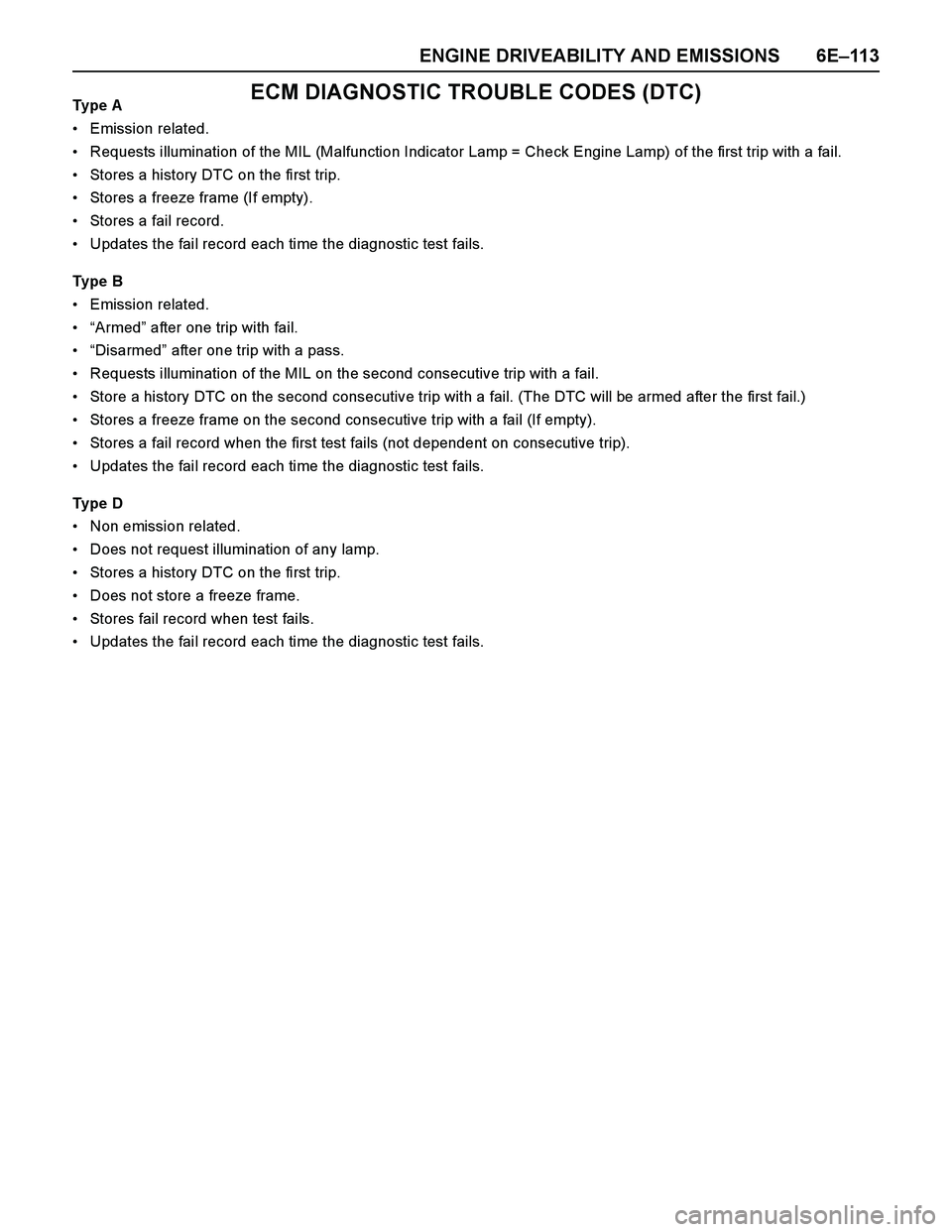
ENGINE DRIVEABILITY AND EMISSIONS 6E–11 3
ECM DIAGNOSTIC TROUBLE CODES (DTC)Type A
Emission related.
Requests illumination of the MIL (Malfunction Indicator Lamp = Check Engine Lamp) of the first trip with a fail.
Stores a history DTC on the first trip.
Stores a freeze frame (If empty).
Stores a fail record.
Updates the fail record each time the diagnostic test fails.
Type B
Emission related.
“Armed” after one trip with fail.
“Disarmed” after one trip with a pass.
Requests illumination of the MIL on the second consecutive trip with a fail.
Store a history DTC on the second consecutive trip with a fail. (The DTC will be armed after the first fail.)
Stores a freeze frame on the second consecutive trip with a fail (If empty).
Stores a fail record when the first test fails (not dependent on consecutive trip).
Updates the fail record each time the diagnostic test fails.
Type D
Non emission related.
Does not request illumination of any lamp.
Stores a history DTC on the first trip.
Does not store a freeze frame.
Stores fail record when test fails.
Updates the fail record each time the diagnostic test fails.
Page 2690 of 4264
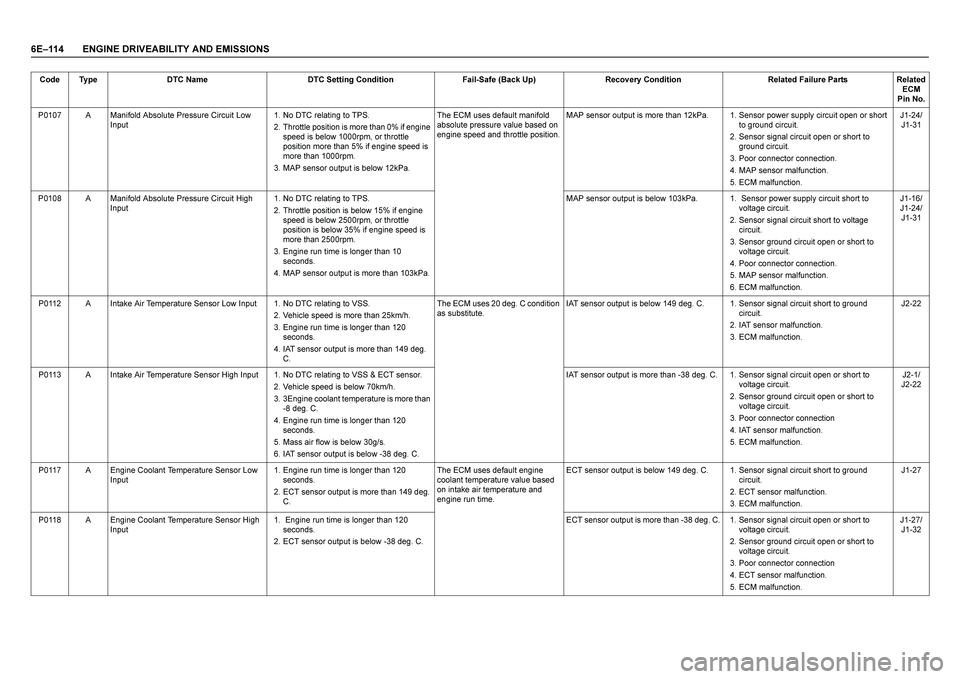
6E–114 ENGINE DRIVEABILITY AND EMISSIONS
Code Type DTC Name DTC Setting Condition Fail-Safe (Back Up) Recovery Condition Related Failure Parts Related
ECM
Pin No.
P0107 A Manifold Absolute Pressure Circuit Low
Input1. No DTC relating to TPS.
2. Throttle position is more than 0% if engine
speed is below 1000rpm, or throttle
position more than 5% if engine speed is
more than 1000rpm.
3. MAP sensor output is below 12kPa.The ECM uses default manifold
absolute pressure value based on
engine speed and throttle position.MAP sensor output is more than 12kPa. 1. Sensor power supply circuit open or short
to ground circuit.
2. Sensor signal circuit open or short to
ground circuit.
3. Poor connector connection.
4. MAP sensor malfunction.
5. ECM malfunction.J1-24/
J1-31
P0108 A Manifold Absolute Pressure Circuit High
Input1. No DTC relating to TPS.
2. Throttle position is below 15% if engine
speed is below 2500rpm, or throttle
position is below 35% if engine speed is
more than 2500rpm.
3. Engine run time is longer than 10
seconds.
4. MAP sensor output is more than 103kPa.MAP sensor output is below 103kPa. 1. Sensor power supply circuit short to
voltage circuit.
2. Sensor signal circuit short to voltage
circuit.
3. Sensor ground circuit open or short to
voltage circuit.
4. Poor connector connection.
5. MAP sensor malfunction.
6. ECM malfunction.J1-16/
J1-24/
J1-31
P0112 A Intake Air Temperature Sensor Low Input 1. No DTC relating to VSS.
2. Vehicle speed is more than 25km/h.
3. Engine run time is longer than 120
seconds.
4. IAT sensor output is more than 149 deg.
C. The ECM uses 20 deg. C condition
as substitute.IAT sensor output is below 149 deg. C. 1. Sensor signal circuit short to ground
circuit.
2. IAT sensor malfunction.
3. ECM malfunction.J2-22
P0113 A Intake Air Temperature Sensor High Input 1. No DTC relating to VSS & ECT sensor.
2. Vehicle speed is below 70km/h.
3. 3Engine coolant temperature is more than
-8 deg. C.
4. Engine run time is longer than 120
seconds.
5. Mass air flow is below 30g/s.
6. IAT sensor output is below -38 deg. C. IAT sensor output is more than -38 deg. C. 1. Sensor signal circuit open or short to
voltage circuit.
2. Sensor ground circuit open or short to
voltage circuit.
3. Poor connector connection
4. IAT sensor malfunction.
5. ECM malfunction.J2-1/
J2-22
P0117 A Engine Coolant Temperature Sensor Low
Input1. Engine run time is longer than 120
seconds.
2. ECT sensor output is more than 149 deg.
C. The ECM uses default engine
coolant temperature value based
on intake air temperature and
engine run time. ECT sensor output is below 149 deg. C. 1. Sensor signal circuit short to ground
circuit.
2. ECT sensor malfunction.
3. ECM malfunction.J1-27
P0118 A Engine Coolant Temperature Sensor High
Input1. Engine run time is longer than 120
seconds.
2. ECT sensor output is below -38 deg. C. ECT sensor output is more than -38 deg. C. 1. Sensor signal circuit open or short to
voltage circuit.
2. Sensor ground circuit open or short to
voltage circuit.
3. Poor connector connection
4. ECT sensor malfunction.
5. ECM malfunction.J1-27/
J1-32
Page 2691 of 4264
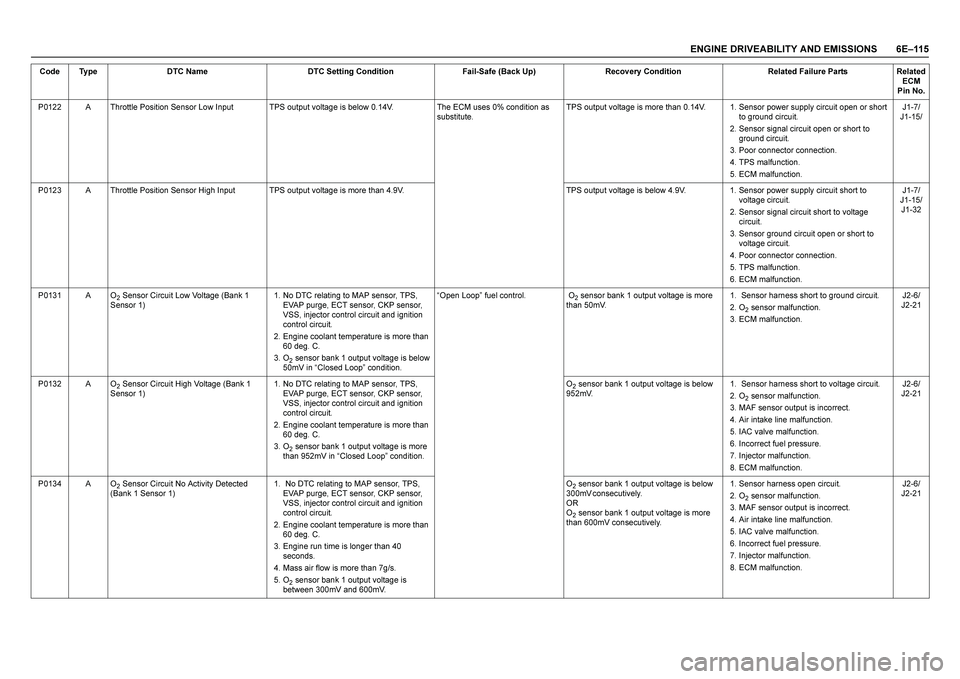
ENGINE DRIVEABILITY AND EMISSIONS 6E–115
P0122 A Throttle Position Sensor Low Input TPS output voltage is below 0.14V. The ECM uses 0% condition as
substitute.TPS output voltage is more than 0.14V. 1. Sensor power supply circuit open or short
to ground circuit.
2. Sensor signal circuit open or short to
ground circuit.
3. Poor connector connection.
4. TPS malfunction.
5. ECM malfunction.J1-7/
J1-15/
P0123 A Throttle Position Sensor High Input TPS output voltage is more than 4.9V. TPS output voltage is below 4.9V. 1. Sensor power supply circuit short to
voltage circuit.
2. Sensor signal circuit short to voltage
circuit.
3. Sensor ground circuit open or short to
voltage circuit.
4. Poor connector connection.
5. TPS malfunction.
6. ECM malfunction.J1-7/
J1-15/
J1-32
P0131 A O
2 Sensor Circuit Low Voltage (Bank 1
Sensor 1)1. No DTC relating to MAP sensor, TPS,
EVAP purge, ECT sensor, CKP sensor,
VSS, injector control circuit and ignition
control circuit.
2. Engine coolant temperature is more than
60 deg. C.
3. O
2 sensor bank 1 output voltage is below
50mV in “Closed Loop” condition. “Open Loop” fuel control. O
2 sensor bank 1 output voltage is more
than 50mV.1. Sensor harness short to ground circuit.
2. O
2 sensor malfunction.
3. ECM malfunction.J2-6/
J2-21
P0132 A O
2 Sensor Circuit High Voltage (Bank 1
Sensor 1)1. No DTC relating to MAP sensor, TPS,
EVAP purge, ECT sensor, CKP sensor,
VSS, injector control circuit and ignition
control circuit.
2. Engine coolant temperature is more than
60 deg. C.
3. O
2 sensor bank 1 output voltage is more
than 952mV in “Closed Loop” condition. O
2 sensor bank 1 output voltage is below
952mV.1. Sensor harness short to voltage circuit.
2. O
2 sensor malfunction.
3. MAF sensor output is incorrect.
4. Air intake line malfunction.
5. IAC valve malfunction.
6. Incorrect fuel pressure.
7. Injector malfunction.
8. ECM malfunction.J2-6/
J2-21
P0134 A O
2 Sensor Circuit No Activity Detected
(Bank 1 Sensor 1)1. No DTC relating to MAP sensor, TPS,
EVAP purge, ECT sensor, CKP sensor,
VSS, injector control circuit and ignition
control circuit.
2. Engine coolant temperature is more than
60 deg. C.
3. Engine run time is longer than 40
seconds.
4. Mass air flow is more than 7g/s.
5. O
2 sensor bank 1 output voltage is
between 300mV and 600mV.O
2 sensor bank 1 output voltage is below
3 0 0 m V c o n s e c u t i v e l y .
O R
O2 sensor bank 1 output voltage is more
than 600mV consecutively.1. Sensor harness open circuit.
2. O
2 sensor malfunction.
3. MAF sensor output is incorrect.
4. Air intake line malfunction.
5. IAC valve malfunction.
6. Incorrect fuel pressure.
7. Injector malfunction.
8. ECM malfunction.J2-6/
J2-21 Code Type DTC Name DTC Setting Condition Fail-Safe (Back Up) Recovery Condition Related Failure Parts Related
ECM
Pin No.
Page 2692 of 4264
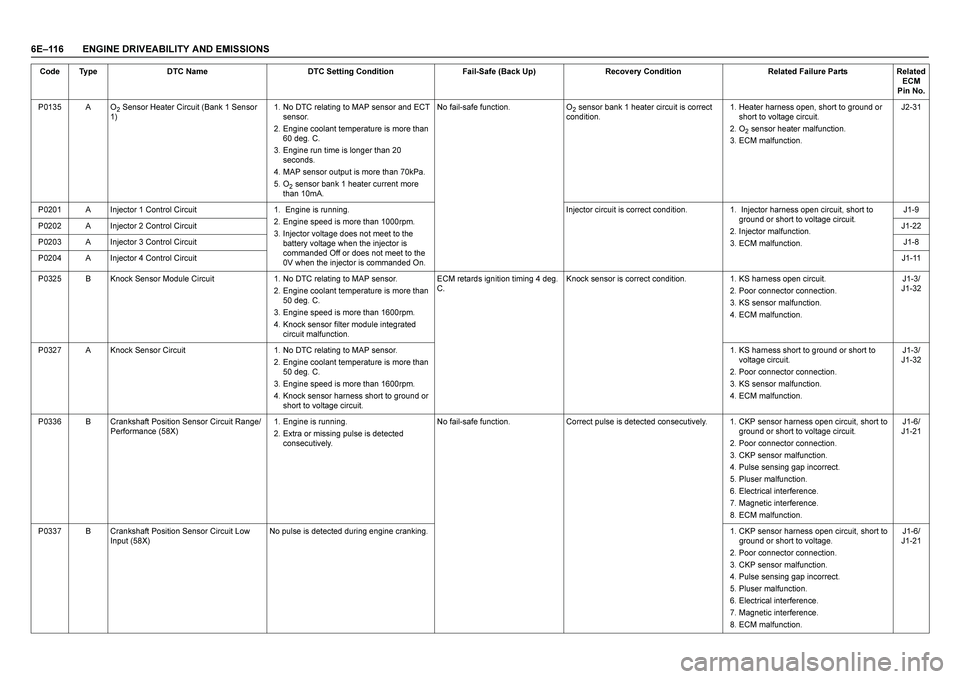
6E–116 ENGINE DRIVEABILITY AND EMISSIONSP0135 A O
2 Sensor Heater Circuit (Bank 1 Sensor
1)1. No DTC relating to MAP sensor and ECT
sensor.
2. Engine coolant temperature is more than
60 deg. C.
3. Engine run time is longer than 20
seconds.
4. MAP sensor output is more than 70kPa.
5. O
2 sensor bank 1 heater current more
than 10mA.No fail-safe function. O
2 sensor bank 1 heater circuit is correct
condition.1. Heater harness open, short to ground or
short to voltage circuit.
2. O
2 sensor heater malfunction.
3. ECM malfunction.J2-31
P0201 A Injector 1 Control Circuit 1. Engine is running.
2. Engine speed is more than 1000rpm.
3. Injector voltage does not meet to the
battery voltage when the injector is
commanded Off or does not meet to the
0V when the injector is commanded On.Injector circuit is correct condition. 1. Injector harness open circuit, short to
ground or short to voltage circuit.
2. Injector malfunction.
3. ECM malfunction.J1-9
P0202 A Injector 2 Control CircuitJ1-22
P0203 A Injector 3 Control CircuitJ1-8
P0204 A Injector 4 Control CircuitJ1-11
P0325 B Knock Sensor Module Circuit 1. No DTC relating to MAP sensor.
2. Engine coolant temperature is more than
50 deg. C.
3. Engine speed is more than 1600rpm.
4. Knock sensor filter module integrated
circuit malfunction.ECM retards ignition timing 4 deg.
C.Knock sensor is correct condition. 1. KS harness open circuit.
2. Poor connector connection.
3. KS sensor malfunction.
4. ECM malfunction.J1-3/
J1-32
P0327 A Knock Sensor Circuit 1. No DTC relating to MAP sensor.
2. Engine coolant temperature is more than
50 deg. C.
3. Engine speed is more than 1600rpm.
4. Knock sensor harness short to ground or
short to voltage circuit.1. KS harness short to ground or short to
voltage circuit.
2. Poor connector connection.
3. KS sensor malfunction.
4. ECM malfunction.J1-3/
J1-32
P0336 B Crankshaft Position Sensor Circuit Range/
Performance (58X)1. Engine is running.
2. Extra or missing pulse is detected
consecutively. No fail-safe function. Correct pulse is detected consecutively. 1. CKP sensor harness open circuit, short to
ground or short to voltage circuit.
2. Poor connector connection.
3. CKP sensor malfunction.
4. Pulse sensing gap incorrect.
5. Pluser malfunction.
6. Electrical interference.
7. Magnetic interference.
8. ECM malfunction.J1-6/
J1-21
P0337 B Crankshaft Position Sensor Circuit Low
Input (58X)No pulse is detected during engine cranking.1. CKP sensor harness open circuit, short to
ground or short to voltage.
2. Poor connector connection.
3. CKP sensor malfunction.
4. Pulse sensing gap incorrect.
5. Pluser malfunction.
6. Electrical interference.
7. Magnetic interference.
8. ECM malfunction.J1-6/
J1-21 Code Type DTC Name DTC Setting Condition Fail-Safe (Back Up) Recovery Condition Related Failure Parts Related
ECM
Pin No.
Page 2693 of 4264
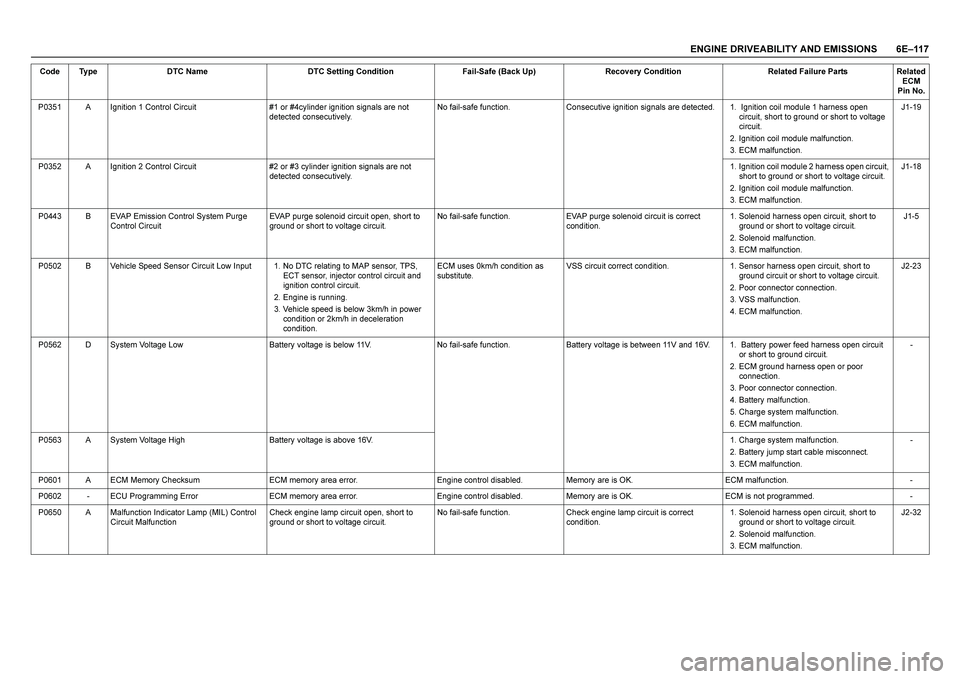
ENGINE DRIVEABILITY AND EMISSIONS 6E–117
P0351 A Ignition 1 Control Circuit #1 or #4cylinder ignition signals are not
detected consecutively.No fail-safe function. Consecutive ignition signals are detected. 1. Ignition coil module 1 harness open
circuit, short to ground or short to voltage
circuit.
2. Ignition coil module malfunction.
3. ECM malfunction.J1-19
P0352 A Ignition 2 Control Circuit #2 or #3 cylinder ignition signals are not
detected consecutively.1. Ignition coil module 2 harness open circuit,
short to ground or short to voltage circuit.
2. Ignition coil module malfunction.
3. ECM malfunction.J1-18
P0443 B EVAP Emission Control System Purge
Control CircuitEVAP purge solenoid circuit open, short to
ground or short to voltage circuit.No fail-safe function. EVAP purge solenoid circuit is correct
condition.1. Solenoid harness open circuit, short to
ground or short to voltage circuit.
2. Solenoid malfunction.
3. ECM malfunction.J1-5
P0502 B Vehicle Speed Sensor Circuit Low Input 1. No DTC relating to MAP sensor, TPS,
ECT sensor, injector control circuit and
ignition control circuit.
2. Engine is running.
3. Vehicle speed is below 3km/h in power
condition or 2km/h in deceleration
condition.ECM uses 0km/h condition as
substitute.VSS circuit correct condition. 1. Sensor harness open circuit, short to
ground circuit or short to voltage circuit.
2. Poor connector connection.
3. VSS malfunction.
4. ECM malfunction.J2-23
P0562 D System Voltage Low Battery voltage is below 11V. No fail-safe function. Battery voltage is between 11V and 16V. 1. Battery power feed harness open circuit
or short to ground circuit.
2. ECM ground harness open or poor
connection.
3. Poor connector connection.
4. Battery malfunction.
5. Charge system malfunction.
6. ECM malfunction.-
P0563 A System Voltage High Battery voltage is above 16V.1. Charge system malfunction.
2. Battery jump start cable misconnect.
3. ECM malfunction.-
P0601 A ECM Memory Checksum ECM memory area error. Engine control disabled. Memory are is OK. ECM malfunction. -
P0602 - ECU Programming Error ECM memory area error. Engine control disabled. Memory are is OK. ECM is not programmed. -
P0650 A Malfunction Indicator Lamp (MIL) Control
Circuit MalfunctionCheck engine lamp circuit open, short to
ground or short to voltage circuit.No fail-safe function. Check engine lamp circuit is correct
condition.1. Solenoid harness open circuit, short to
ground or short to voltage circuit.
2. Solenoid malfunction.
3. ECM malfunction.J2-32 Code Type DTC Name DTC Setting Condition Fail-Safe (Back Up) Recovery Condition Related Failure Parts Related
ECM
Pin No.